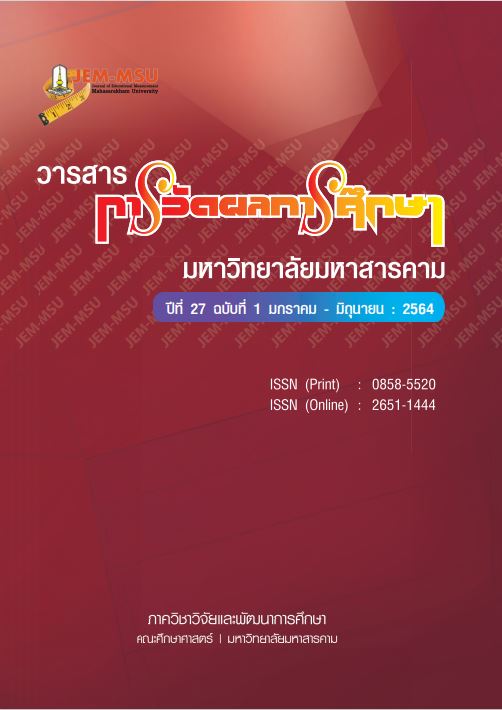A Network Meta-Analysis of Teaching Method Influencing Mathematics Achievement of Students
Main Article Content
Abstract
The aims of this research were 1) to analyze the total effect size and variation of the effect size of teaching methods on mathematics achievement of students, 2) to study characteristics of research that influence the effect size of teaching methods on mathematics achievement of students, and 3) to compare the effect size of teaching methods on mathematics achievement of students. The sample consisted of 20 researches selected according to PICO and PRISMA and analyzed by using effect size analysis, moderation analysis, and network meta- analysis.
The key findings were as follows: 1) The total effect size of the teaching methods on mathematics achievement of students was 0.63. 2) The effect sizes of the teaching methods on mathematics achievement of students in each research had high heterogeneity with statistical significance at the .05 level (Q (30) =164.62, p < .001, I2 = 79.43%). 3)The characteristics of research influencing the effect size of the teaching methods on mathematics achievement of students were location and controlling covariate. 4) A result of the network meta-analysis showed that the highest effect size of teaching methods was transfer, and the least effect size of teaching methods was program technology.
Article Details
The content and information contained in the published article in the Journal of Educational Measurement Mahasarakham University represent the opinions and responsibilities of the authors directly. The editorial board of the journal is not necessarily in agreement with or responsible for any of the content.
The articles, data, content, images, etc. that have been published in the Journal of Educational Measurement Mahasarakham University are copyrighted by the journal. If any individual or organization wishes to reproduce or perform any actions involving the entirety or any part of the content, they must obtain written permission from the Journal of Educational Measurement Mahasarakham University.
References
ชนินทร์ ตั้งพานทอง. (2560). ปัจจัยที่มีต่อผลสัมฤทธิ์ทางการเรียนออนไลน์เพื่อเสริมการเรียนการสอน. วิทยานิพนธ์วิทยาศาสตรมหาบัณฑิต จุฬาลงกรณ์มหาวิทยาลัย.
ฐิติพร สังขรัตน์. (2558). การพัฒนารูปแบบการเรียนการสอนตามแนวคิดการถ่ายโยงการเรียนรู้ร่วมกับทฤษฎีการเรียนรู้จากตัวแบบเพื่อสร้างเสริมความสามารถในการเขียนเรียงความภาษาไทยของนักศึกษาระดับปริญญาบัณฑิต. วิทยานิพนธ์ปรัชญาดุษฎีบัณฑิต มหาวิทยาลัยศิลปากร.
ณัฐพงษ์ กอสวัสดิ์พัฒน์. (2559). ผลของการจัดกิจกรรมการเรียนรู้คณิตศาสตร์โดยใช้วงจรการเรียนรู้ตามการสืบสอบแบบแนะแนวทางร่วมกับการเขียนบันทึกการเรียนรู้ที่มีต่อความรู้และความสามารถในการให้เหตุผลทางคณิตศาสตร์ของนักเรียนมัธยมศึกษาตอนปลาย. วิทยานิพนธ์ครุศาสตรมหาบัณฑิต จุฬาลงกรณ์มหาวิทยาลัย.
ปิยวดี ฆายะนานนท์. (2554). ผลของการฝึกการอนุมานสาเหตุตามหลักธรรมเรื่องความเพียรที่มีต่อความวิตกกังวลในวิชาคณิตศาสตร์และผลสัมฤทธิ์ทางการเรียนวิชาคณิตศาสตร์ของนักเรียนประถมศึกษาปีที่ 6. วิทยานิพนธ์ครุศาสตรมหาบัณฑิต จุฬาลงกรณ์มหาวิทยาลัย.
ศุภลักษณ์ ครุฑคง. (2556). ผลของการจัดกิจกรรมการเรียนรู้คณิตศาสตร์โดยใช้วิธี IMPROVE และการเขียนบันทึกการเรียนรู้ ที่มีต่อความรู้ทางคณิตศาสตร์และความสามารถในการเชื่อมโยงความรู้ทางคณิตศาสตร์ของนักเรียนมัธยมศึกษาปีที่ 2. วิทยานิพนธ์ครุศาสตรมหาบัณฑิต จุฬาลงกรณ์มหาวิทยาลัย.
สายสุณี สุทธิจักษ์. (2551). ผลของการจัดการเรียนการสอนโดยใช้การตั้งปัญหาเสริมกระบวนการแก้ปัญหาที่มีต่อความสามารถในการแก้ปัญหาและความสามารถในการให้เหตุผลทางคณิตศาสตร์ของนักเรียนชั้นมัธยมศึกษาปีที่ 2 จังหวัดหนองคาย. วิทยานิพนธ์ครุศาสตรมหาบัณฑิต จุฬาลงกรณ์มหาวิทยาลัย.
สิรีรัศน์ ผลขวัญโชติกา. (2554). ผลของการจัดกิจกรรมการเรียนรู้คณิตสาสตร์โดนใช้รูปแบบการเรียนการสอน 4E x 2 ที่มีต่อมโนทัศน์และความสามารถในการแก้ปัญหาทางคณิตศาสตร์ของนักเรียนมัธยมศึกษาปีที่ 3. วิทยานิพนธ์ครุศาสตรมหาบัณฑิต จุฬาลงกรณ์มหาวิทยาลัย.
สุนันทา บ้านกล้วย. (2556). ผลของการจัดการเรียนการสอนแบบ 4MAT ที่มีต่อผลสัมฤทธิ์ทางการเรียนและทักษะการเชื่อมโยงทางคณิตศาสตร์ เรื่องการวัด ของนักเรียนชั้นมัธยมศึกษาปีที่ 2. วิทยานิพนธ์ศึกษาศาสตร์มหาบัณฑิต มหาวิทยาลัยศรีนครินทรวิโรฒ.
เสาวรัตน์ รามแก้ว. (2552). ผลของการจัดกิจกรรมการเรียนรู้คณิตศาสตร์โดยใช้การสืบสอบแบบแนะแนวทางที่มีต่อมโนทัศน์และความสามารถในการให้เหตุผลทางคณิตศาสตร์ของนักเรียนมัธยมศึกษาปีที่ 2. วิทยานิพนธ์ครุศาสตรมหาบัณฑิต จุฬาลงกรณ์มหาวิทยาลัย.
หทัยรัตน์ ยศแผ่น. (2556). ผลของการจัดกิจกรรมการเรียนรู้คณิตศาสตร์โดยใช้กลวิธีการเสริมต่อการเรียนรู้ที่มีต่อมโนทัศน์และความสามารถในการสื่อสารทางคณิตศาสตร์ของนักเรียนชั้นมัธยมศึกษาปีที่ 2. วิทยานิพนธ์ครุศาสตรมหาบัณฑิต จุฬาลงกรณ์มหาวิทยาลัย.
อรญา อัญโย. (2553). ผลของการจัดกิจกรรมการเรียนรู้คณิตศาสตร์โดยบูรณาการการใช้ตัวแทนที่หลากหลายและเครื่องคำนวณเชิงกราฟที่มีต่อมโนทัศน์ทางคณิตศาสตร์และความสามารถในการแก้ปัญหาคณิตศาสตร์เรื่องฟังก์ชัน. วิทยานิพนธ์ครุศาสตรมหาบัณฑิต จุฬาลงกรณ์มหาวิทยาลัย.
อัญชนา กลิ่นเทียน. (2553). ผลของการมอบหมายบทบาทในการเรียนแบบแก้ปัญหาด้วยสถานการณ์จาลองบนเว็บที่มีต่อความสามารถในการแก้ปัญหาและผลสัมฤทธิ์ทางการเรียนของนักเรียนมัธยมศึกษาปีที่ 2 ที่มีระดับเชาวน์ปัญญาด้านตรรกะทางคณิตศาสตร์ต่างกัน. วิทยานิพนธ์ครุศาสตรมหาบัณฑิต จุฬาลงกรณ์มหาวิทยาลัย.
อิสริยา ปรมัตถากร. (2556). การพัฒนาความรู้และความสามารถในการเชื่อมโยงทางคณิตศาสตร์โดยการจัดกิจกรรมการเรียนรู้คณิตศาสตร์ตามแนวทฤษฎีพหุปัญญาของนักเรียนประถมศึกษาปีที่ 5. วิทยานิพนธ์ครุศาสตรมหาบัณฑิต จุฬาลงกรณ์มหาวิทยาลัย.
Cipriani, A. (2016). What have network meta-analyses taught us about treatment of mood disorder: is it time to revisit the hierarchy of evidence?. Retrieved December 20, 2018, from https://ora.ox.ac.uk/objects/uuid:a71052d0-87a2-4c5c-b082-fcc6dfd683dd.
Clark, T. (2017). The K-12 service-learning standards and fourth grade students' math achievement: A quasi-experimental study in georgia (Order No. 10743197). Available from ProQuest Dissertations & Theses Global. (2009417844). https://search.proquest.com/docview/ 2009417844?accountid=15637
Del Re, A. C. (2015). A practical tutorial on conducting meta-analysis in r. The Quantitative Methods for Psychology, 11(1), 37-50. http://doi.org/10.20982/tqmp.11.1p037
Eyyam, R., & Yaratan, H. S. (2014). Impact of use of technology in mathematics lessons on student achievement and attitudes. Social Behavior and Personality: an international journal, 42(1), 31S-42S.
Faber, J. M., Luyten, H., & Visscher, A. J. (2017). The effects of a digital formative assessment tool on mathematics achievement and student motivation: Results of a randomized experiment. Computers & education, 106, 83-96. https://doi.org/10.1016/j.compedu.2016.12.001
Hailikari, T., Nevgi, A., & Komulainen, E. (2008). Academic self‐beliefs and prior knowledge as predictors of student achievement in Mathematics: A structural model. Educational psychology, 28(1), 59-71.
Hawkins, C. (2015). Instantaneous teacher feedback to improve student math achievement of 4th grade student: A quasi-experimental design of a classroom math intervention (Master's thesis).
Henderson, A. T. & Mapp, K. L. (2002). A new wave of evidence: The impact of school, family, and community connections on student achievement. Washington, DC. Southwest Educational Development Lab.
Hofmann, R. & Mercer, N. (2016). Teacher interventions in small group work in secondary mathematics and science lessons. Language and Education, 30:5, 400-416, http://doi.org/10.1080/ 09500782.2015.1125363
Jeynes, W. H. (2019). A meta-analysis on the relationship between character education and student achievement and behavioral outcomes. Education and Urban Society, 51(1), 33-71, http://doi.org/10.1177/0013124517747681.
Kebritchi, M., Hirumi, A., & Bai, H. (2010). The effects of modern mathematics computer games on mathematics achievement and class motivation. Computers & education, 55(2), 427-443. https://doi.org/10.1016/j.compedu.2010.02.007
Lai, Y. H. (2019). A network meta-analysis on the effects of information and communication technology on students’ learning achievementin Taiwan. EURASIA Journal of Mathematics, Science and Technology Education, 15(3). http://doi.org/10.29333/ejmste/102846
Lockhart-Findling, M. (2016). The relationship between two types of teacher professional development and head start student math outcomes (Order No. 10157900). Available from ProQuest Dissertations & Theses Global. (1837406975). https://search.proquest.com /docview/ 1837406975?accountid=15637
Mcknight, K., O’Malley, K., Ruzic, R., Horsley, M. K., Franey, J. J., & Bassett, K. (2016). Teaching in a digital age: How educators use technology to improve student learning. Journal of Research on Technology in Education, 48(3), 194-211. http://doi.org/10.1080/15391523.2016.1175856.
OECD. (2016). Equations and Inequalities: Making Mathematics Accessible to All. Retrieved April 20, 2020, from https://www.oecd-ilibrary.org/docserver/9789264258495-en.pdf?expires=1587371901&id=id&accname=guest&checksum=DD6F8AB7D4B3932B57ACA4EB4C2AADB3
OECD. (2017). How does PISA for Development measure mathematical literacy?. Retrieved December 20, 2018, from https://www.oecd.org/pisa/aboutpisa/9-How-PISA-D-measures-math-literacy.pdf
Pilli, O., & Aksu, M. (2013). The effects of computer-assisted instruction on the achievement, attitudes and retention of fourth grade mathematics students in North Cyprus. Computers & Education, 62, 62-71.
Sarrell, D. M. (2014). The effects of reflex math as a response to intervention strategy to improve math automaticity among male and female at-risk middle school students (Order No. 3632484). Available from ProQuest Dissertations & Theses Global. (1570196386). https://search.proquest.com/docview/1570196386?accountid=15637.
Scott, S. M. (2014). The effects of math tutoring sessions for parents on eighth grade students' mathematics achievement and anxiety (Order No. 3619094). Available from ProQuest Dissertations & Theses Global. (1530479624). https://search.proquest.com/ docview/1530479624?accountid=15637.
Throndike, E. L. (1913). Educational psychology: Vol.2. The psychology of learning. New York: Columbia University Press.
Yilmaz, B. (2017). Effects of Adaptive Learning Technologies on Math Achievement: A Quantitative Study of ALEKS Math Software (Doctoral dissertation, University of Missouri--Kansas City).


